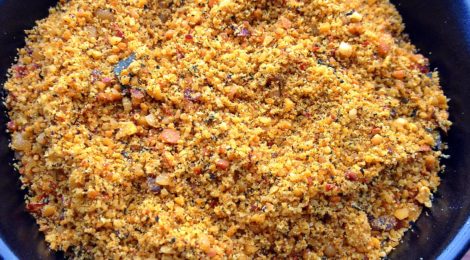
Karnataka-Style Chutney Pudi

Chutney pudi, which translated is chutney “powder” is a popular condiment in South India
While most of you probably know what a chutney is, if you’re not from South India, you might be wondering what “chutney pudi” is. A ‘pudi’ translates to ‘powder.’ So, “chutney pudi” as the name suggests, can be called a dry chutney. It is a ground mixture of dry-roasted herbs and spices that tastes spicy, sweet, sour, and salty all at the same time thanks to ingredients like dry red chilli, dry unsweetened coconut, and jaggery (palm sugar). There are different kinds of chutney pudis based on the main ingredient being showcased (i.e. dried curry leaves or kari patha leaves are the main component of a “kari patha chutney pudi”). Chutney pudi is a staple condiment for many South Indians, and like most pickles or chutneys, it’s eaten in small quantities to enhance the overall flavor profile of items on your plate. In Karnataka, chutney pudi is traditionally mixed with steamed rice and ghee (clarified butter) or combined with plain yogurt and served as a dip with a South Indian crispy snack called chaklis (or chakris). Like coffee, it can be a fine grind or a coarse grind. My absolute favorite is when it’s a coarse grind, like the photo above. I sprinkle chutney pudi on as many things as I can, including pasta and pizza. It makes everything taste better, honestly. Sean laughs whenever I pull it out of the cupboard with a big smile on my face. There is nothing like homemade chutney pudi.

Some of the main ingredients in chutney pudi — classic South Indian flavors. Starting from top left to right: dry red chillies, uncooked channa dal, dry unsweetened coconut, and jaggery (palm sugar)
Saroja Aunty was my mom’s older sister who lived in Bangalore, and made the best chutney pudi I’ve EVER had. This is the recipe I share with you below. Hers was coarsely ground and she always achieved the perfect texture, color, taste, and balance of flavors. I like it coarse because I can taste distinct bits of toasted coconut blending effortlessly with darkened palm sugar and channa dal with just the right bite from the red chillis.

Saroja Aunty was my mom’s older sister and made the best homemade chutney pudi I’ve ever had. Here she is around 1945 pictured with her husband, Rajaratnam Uncle. She passed away in 2013 and our extended family still talks about her chutney pudi.
Growing up in Canada, I would sometimes visit India during the summer holidays. The first stop was always Saroja Aunty’s house on 8th Main Road in Vasanth Nagar near Mount Carmel College in Bangalore. I still consider it my Bangalore home, and can picture sitting at the dining table at 8 years old watching Saroja Aunty pull out her stainless steel container of homemade chutney pudi. She passed away in 2013. I miss her and think of her often. I miss her house too. It’s since been turned into a Café and Pâtisserie called Desserted whose Le Cordon Bleu-trained pastry chef describes it as a place to “stop by for a coffee, pastry, quick bite or a long chat.” My Saroja Aunty was a tough lady who was full of life and loved to host a diverse set of friends in her home. I think she would’ve liked the idea her home being a café and pâtisserie today, constantly filled with vibrant people and interesting conversations. After all, her house was the place where we would all would stop by for coffee, a quick bite, or a long chat.
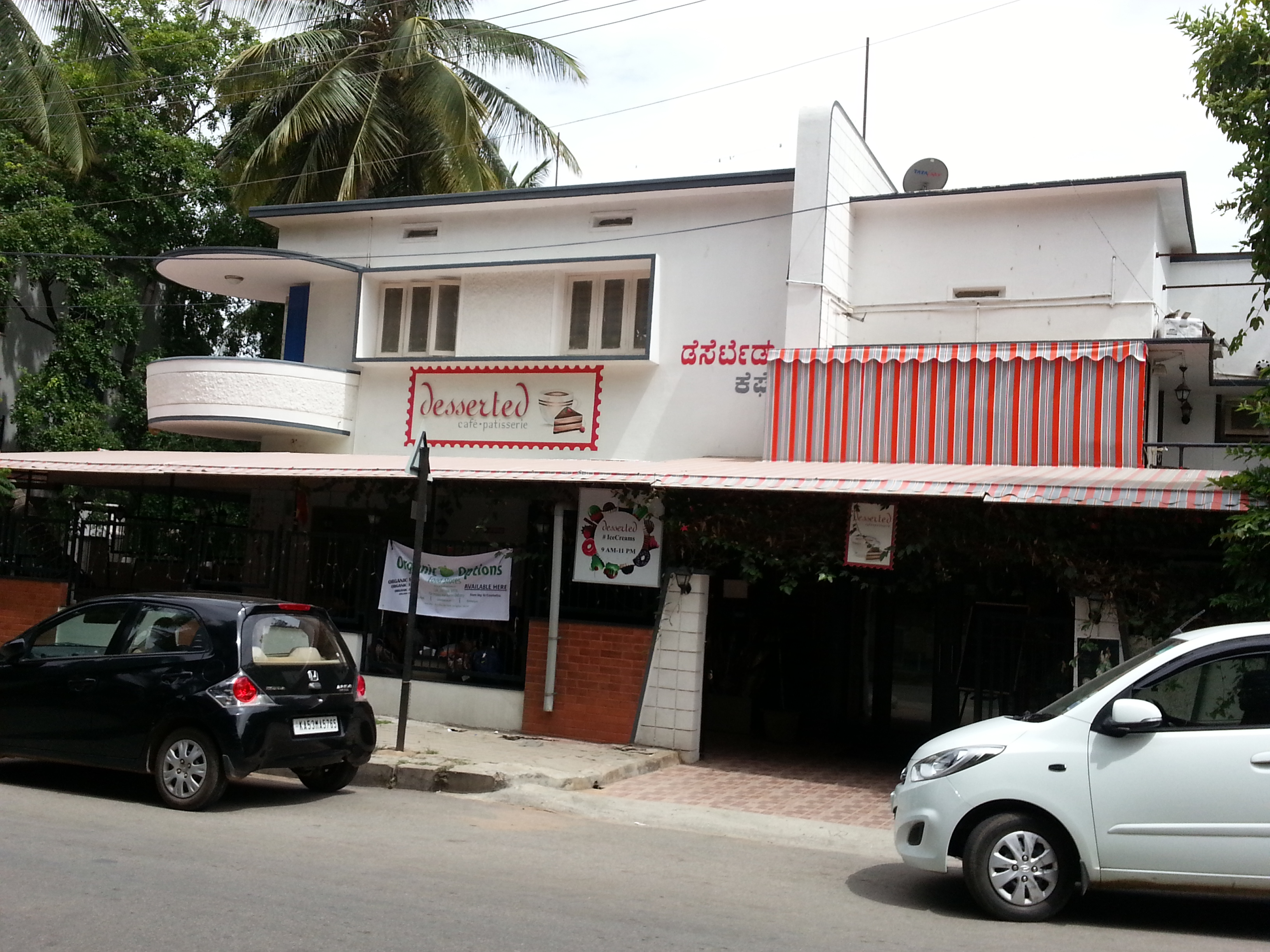
Today, Saroja Aunty’s house is a cafe and patisserie called Desserted in Bangalore, India
Karnataka-style Chutney Pudi
Ingredients
- 1 cup urad dal
- 1 1/2 cups channa dal
- 20 dried red chillies – “Byaddagi” or “Kashmiri” variety
- 1 1/2 tablespoons brown sugar (or powdered jaggery)
- 1 cup dry unsweetened coconut
- 1 1/2 tablespoons tamarind root cut in small pieces
- 1 cup kari patha (curry leaves)
- 3/4 teaspoon salt
- 2 teaspoons canola or vegetable oil, divided
Preparation
- Set aside three medium size bowls and one large bowl.
- In a small frying pan on low heat, dry roast channa dal until it is aromatic & light red in color. Do not brown. Transfer to one medium size bowl and let it cool.
- In the same frying pan on low heat, dry roast urad dal until it is aromatic & light red in color. Do not brown. Transfer to the second medium size bowl and let it cool.
- In the same frying pan on low heat, roast red chillies with 1 teaspoon of oil until they are slightly brown. Transfer to the third medium size bowl and let it cool.
- In the same frying pan on low heat, roast kari patha (curry leaves) with 1 teaspoon of oil for 1-2 minutes until they are crisp. Add to the third bowl with the roasted red chillies.
- In the same frying pan on low heat, dry roast unsweetened coconut for no more than 30 seconds. Add to the third bowl with the roasted red chillies and curry leaves.
- Cut tamarind into small pieces and in the same frying pan on low heat, roast for 1 minute. Add to the third bowl with the roasted red chillies, curry leaves and coconut.
- Let everything cool to room temperature.
- In a food processor OR blender, coarse grind the channa dal for one minute. Then add the urad dal and continue grinding until the whole mixture is coarse ground (not finely ground). Transfer to the large bowl.
- In the same food processor OR blender, grind all the remaining ingredients until coarse ground. Add mixture to the large bowl with the coarse ground channa dal and urad dal.
- Add salt and brown sugar, and mix well.
- Taste and adjust the seasonings as desired.
Note: Instead of fresh tamarind, you can use tamarind powder (1 ½ tablespoons) or 1 teaspoon sour salt.
UPDATE!
For those of you who are planning to make this terrific chutney pudi recipe, here are additional photos of what the roasted red chillis should look like — in response to B’s question down below:
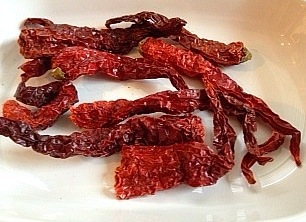
These dried red chillies – “Byaddagi” or “Kashmiri” variety — look like this before roasting…
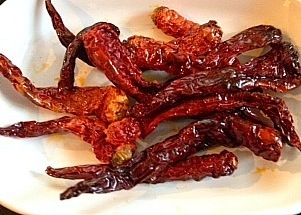
…and should like like this after 2-3 minutes — remove them from the heat immediately otherwise they will be overdone
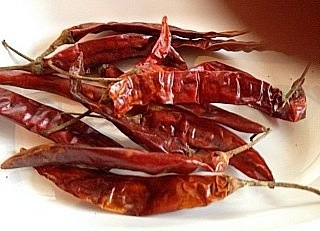
For standard run-of-the-mill dried red chillis, they should look like this before roasting…
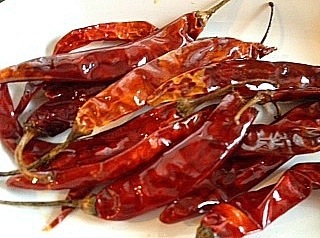
…and look like this after 1 minute, whereupon remove them from the heat immediately
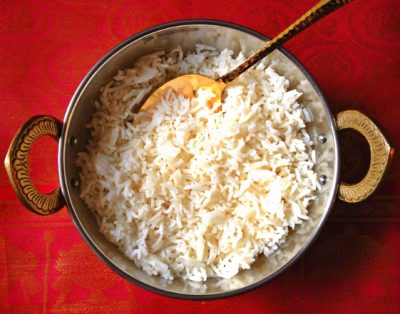


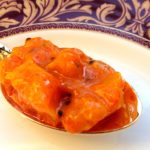
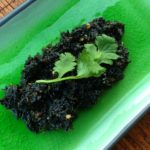
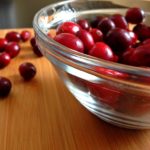
Hi!
My husband and I both love this chutney pudi recipe and have been using this recipe for three years now😊 We live in Bangalore where varieties of chutney pudis are easily available and even though our mothers have their own tasty recipes, this recipe is just mind blowing.
We often used to visit that Desserted cafe and I was really excited read about it here..
Hello Adithi! Thank you for visiting Big Apple Curry. I’m just delighted that you love this particular recipe and have been using it for three years! I will tell my mom and aunties all about your note! Plus, you’ve visited the Desserted Cafe, which was my Saroja Aunty’s former home, and this is her recipe! With warmest wishes, Ina
Soft rice idli with a spoon of home made ghee spread on top and sprinkle chatni pudi on top of the ghee…the best south indian breakfast…Thank you for this post, very nostalgic and the period photo..depicting the Aura of those times..simplicity of life and un adultrated food… Memories can be painfully nostalgic… God bless you for remembering your aunt often….
Dear Ramesh!
I loved reading your comment because you understand exactly where I’m coming from — chutney pudi can make a dish really sing 🙂 You may not believe it, but I’ve never sprinkled chutney pudi on top of idlis! I will definitely give that a try. I always have it with rice (or atop other things like pasta and pizza). My aunt was a special lady, and I think of her often. She was strong-minded and bold, and I can’t help but wonder what she would’ve become had she been born in a different time. Warmest wishes to you and your family.
Love collecting various podis – have a lovely peanutty one atm that my friend brought back from her last India trip, along with homemade urid laddoos, Goan dodol, her mum’s garam masala and more : D
Hi Zoe! That’s fantastic! I have never had a peanut pudi, but now I want to try it! Do you have a recipe for it? Homemade garam masala from India sounds divine — you clearly have an Indian pantry in your kitchen! Which pudi do you like the best so far, and what do you typically eat it with? Great to hear from you!
No idea on the recipe for the nutty podi, but just got a jar of Double Horse brand Keralite Chammanthi (cocnut-tamarind podi) for which there’s a homemade recipe here:
http://www.kothiyavunu.com/2012/01/nadan-chammanthi-podi-idi-chammanthi.html
The garam masala I have is from a Punjabi lady settled in Maharashtra – one of the reasons I love it is that it lacks the ground coriander I’m not big on (added separately in the recipes she uses it in) Also has the lovely depth of dagad phool!
Apart from that I have a pickle masala from a South African-Gujarati friend, garam masala made in Birmingham, UK by an East African Indiann mate’s mother, and goda masala and a Malvani masala from Maharashtra 😀
Ina, I have a question. I have tried making chutney pudi 3-4 times. Everything else is fine except I always seem to over fry/roast the red chillis. Almost all the recipes say ‘fry the red chilli’ but I really dont know how/when to stop roasting them. It is easy to tell when the dals are roasted due to their pink/red color.
The other thing is, the byadgi chillis are crinkled and dont change color easily, so please help with this!! (photos will help!)
Hello B!
You’re right, most recipes, including mine, say to dry roast the red chillis but don’t say how long. Try this: dry roast the red chillis for only one minute — this should be enough time for them become slightly brown. The key is the red chillis should be aromatic — the method of dry roasting releases the oils, so as soon as you smell the roasted chilli, remove them from the heat. That said, the exact time depends on the type of heat you’re using (gas burner versus electric burner) so going by smell is the easiest way. Yes, Byadagi chillies are crinkly and do take longer than a minute, perhaps 2 or 3 minutes. The important thing Is to slightly roast them, and they should not be overly roasted. I will try to take photos soon, in the meantime, I hope this helps! Let me know how it goes!
Hello B! See the photos I’ve posted above, that should help you visualize what the roasted chillis should look like.
Update: Today I made another batch of chutney pudi.
I kept my computer next to the stove and observed the pictures (of the roasted chillis) as I was roasting the chillis and also kept a tab of the time. I did pretty well!
Thank you for thoughtfully posting both the BEFORE and AFTER pictures of the red chillis. Pictures and the approximate time, both helped!!
On a side note, I am amazed how I am able to connect to another person across the country over one pudi, which is one of the million food items of the world!
Hello B! I love it! I’m delighted that the photos were helpful to you — I often prop up my iPad in the kitchen while I’m following a recipe, I can picture exactly what you did. Happy to help — there is nothing like having a craving for chutney pudi and getting the balance just right! You’re absolutely right, given the multitude of food items in the world, it’s quite a thing to connect over something like chutney pudi 🙂
We buy bland chutney podi from an Indian grocer here. Need to try making it! Thanks for the recipe!! Lovely blog, btw!!!
Hello Anjana and welcome to Big Apple Curry! I know exactly what you mean — I used to buy pre-packaged chutney pudi at the Indian grocer but it was either bland or too hot. Making the real thing at home is actually quite easy! Love your blog too!